外研(新标准)版九年级下册Module1 Travel Unit3 Language in use课件(共45张PPT)
文档属性
| 名称 | 外研(新标准)版九年级下册Module1 Travel Unit3 Language in use课件(共45张PPT) | 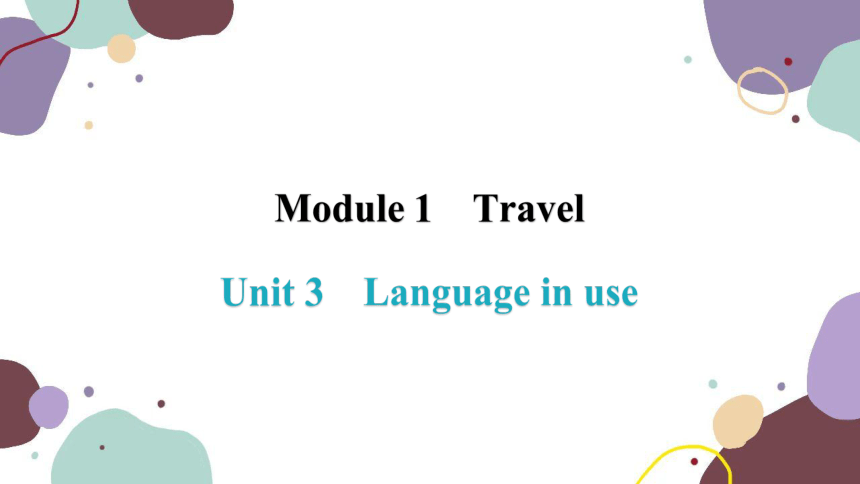 | |
| 格式 | pptx | ||
| 文件大小 | 456.7KB | ||
| 资源类型 | 教案 | ||
| 版本资源 | 外研版 | ||
| 科目 | 英语 | ||
| 更新时间 | 2023-06-24 10:14:56 | ||
图片预览

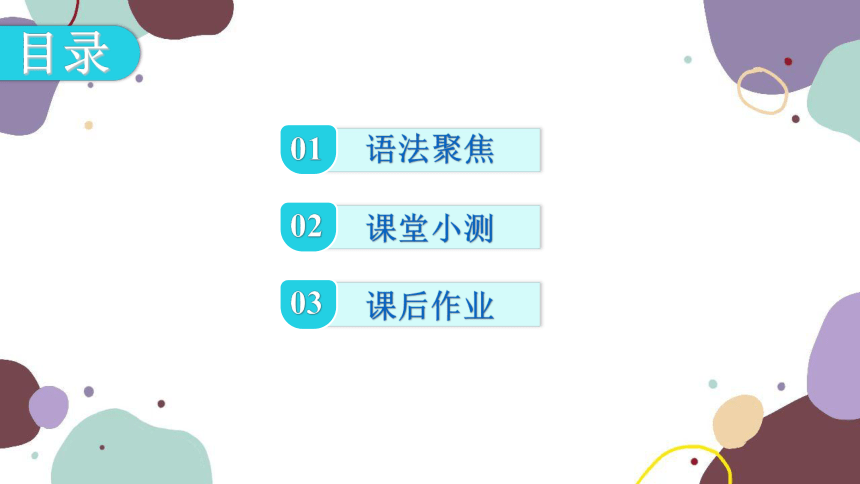
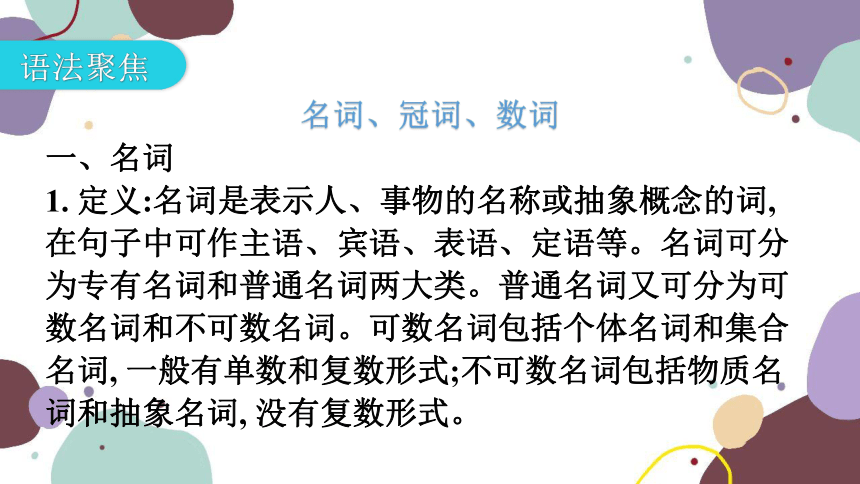
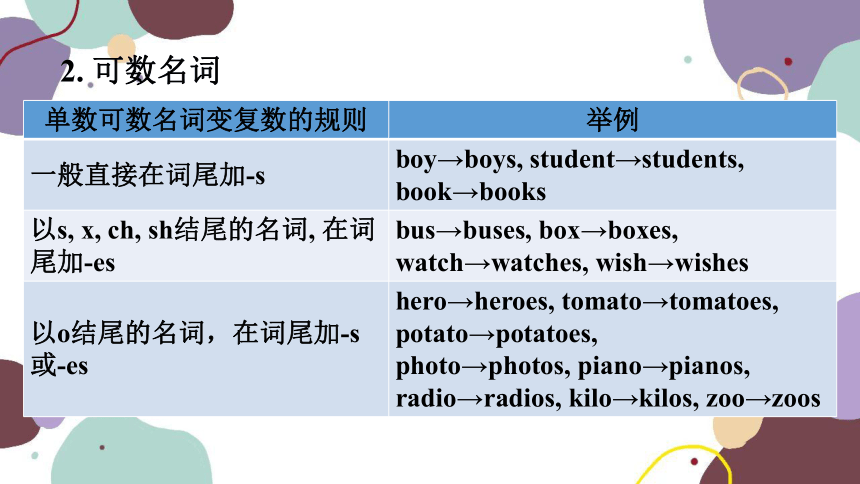
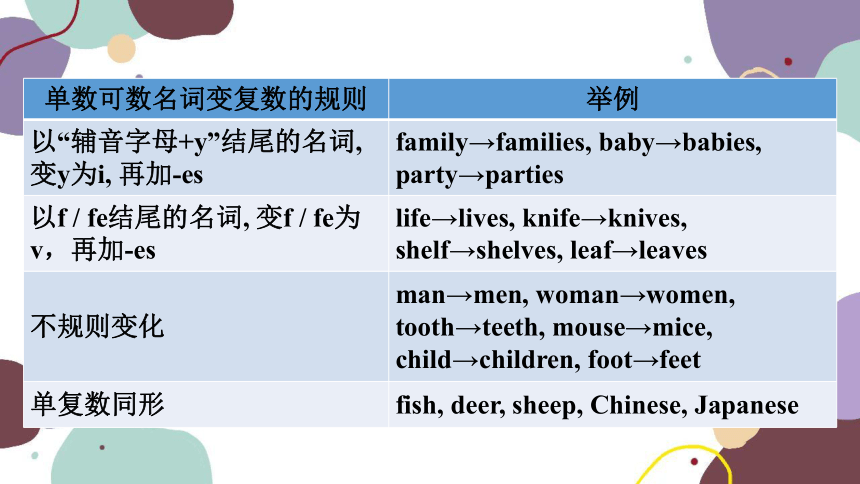
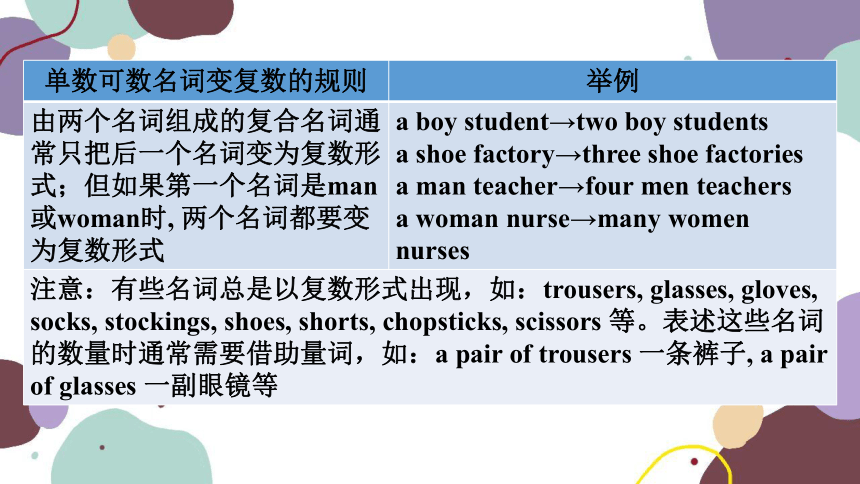
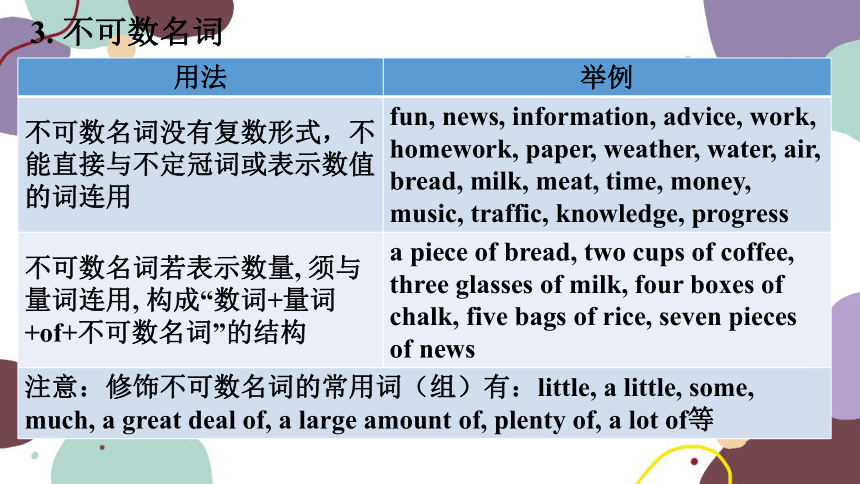
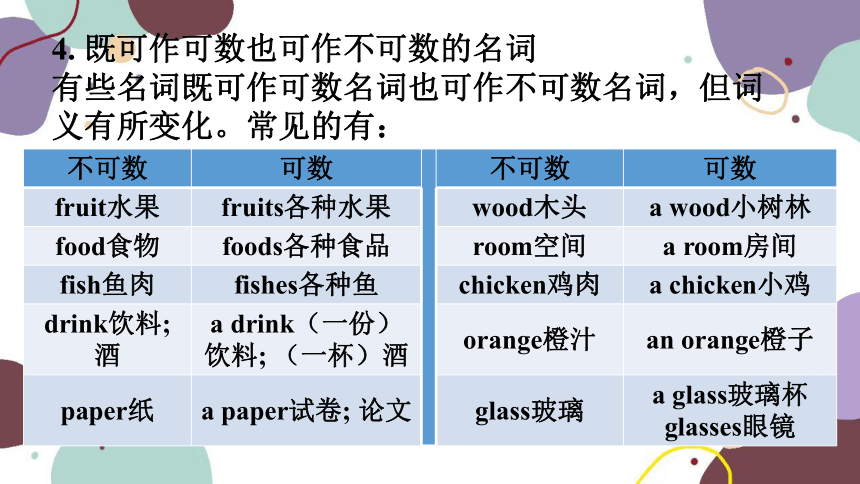
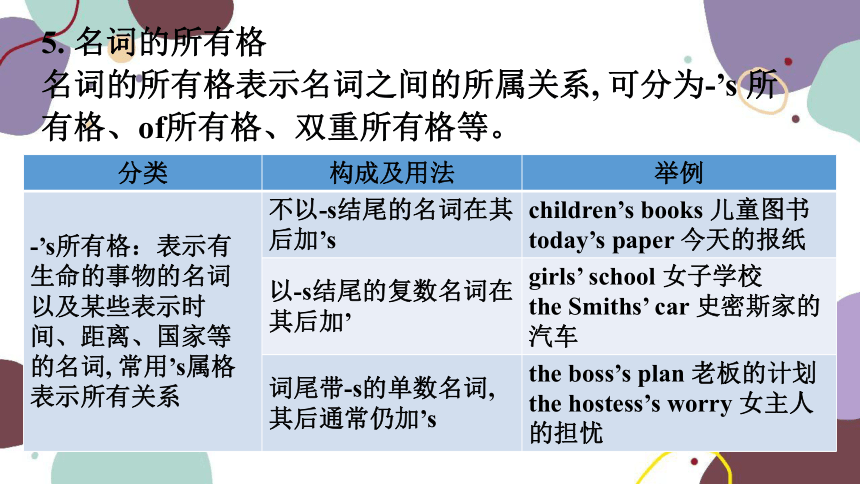
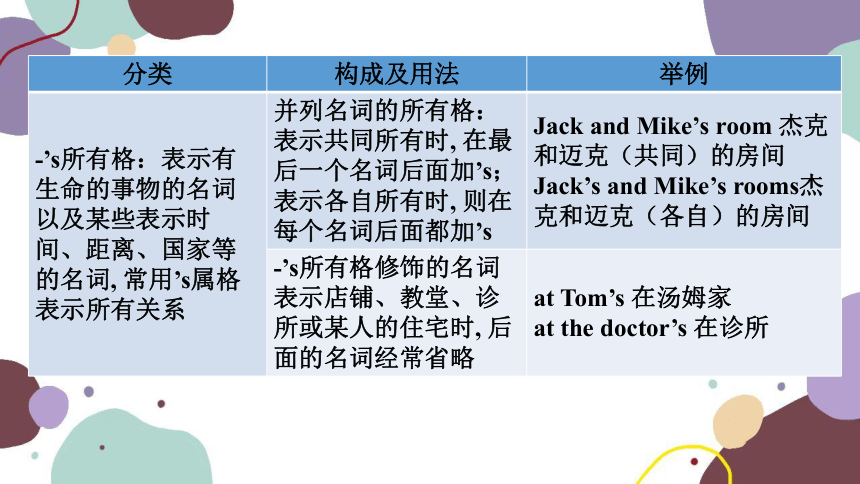
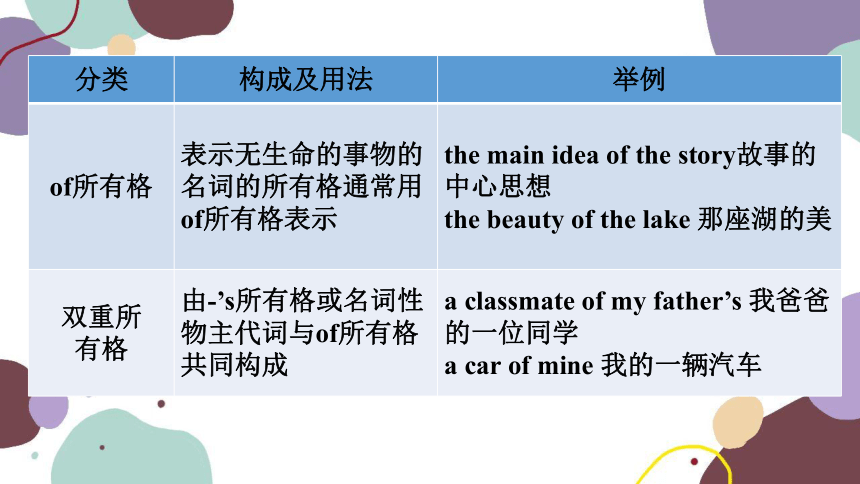
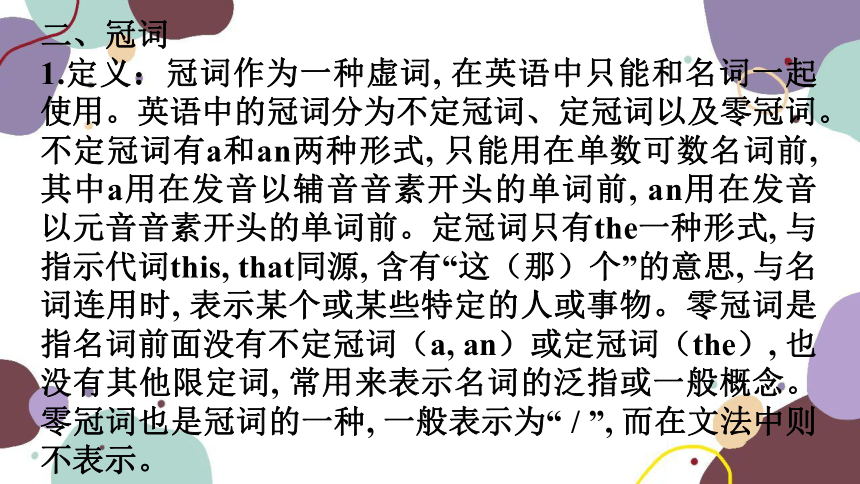
文档简介
(共45张PPT)
Module 1 Travel
Unit 3 Language in use
目录
课堂小测
02
课后作业
03
01
语法聚焦
语法聚焦
名词、冠词、数词
一、名词
1. 定义:名词是表示人、事物的名称或抽象概念的词, 在句子中可作主语、宾语、表语、定语等。名词可分为专有名词和普通名词两大类。普通名词又可分为可数名词和不可数名词。可数名词包括个体名词和集合名词, 一般有单数和复数形式;不可数名词包括物质名词和抽象名词, 没有复数形式。
2. 可数名词
单数可数名词变复数的规则 举例
一般直接在词尾加-s boy→boys, student→students, book→books
以s, x, ch, sh结尾的名词, 在词尾加-es bus→buses, box→boxes, watch→watches, wish→wishes
以o结尾的名词,在词尾加-s或-es hero→heroes, tomato→tomatoes, potato→potatoes,
photo→photos, piano→pianos, radio→radios, kilo→kilos, zoo→zoos
单数可数名词变复数的规则 举例
以“辅音字母+y”结尾的名词, 变y为i, 再加-es family→families, baby→babies, party→parties
以f / fe结尾的名词, 变f / fe为v,再加-es life→lives, knife→knives, shelf→shelves, leaf→leaves
不规则变化 man→men, woman→women, tooth→teeth, mouse→mice, child→children, foot→feet
单复数同形 fish, deer, sheep, Chinese, Japanese
单数可数名词变复数的规则 举例
由两个名词组成的复合名词通常只把后一个名词变为复数形式;但如果第一个名词是man或woman时, 两个名词都要变为复数形式 a boy student→two boy students
a shoe factory→three shoe factories
a man teacher→four men teachers
a woman nurse→many women nurses
注意:有些名词总是以复数形式出现,如:trousers, glasses, gloves, socks, stockings, shoes, shorts, chopsticks, scissors 等。表述这些名词的数量时通常需要借助量词,如:a pair of trousers 一条裤子, a pair of glasses 一副眼镜等
3. 不可数名词
用法 举例
不可数名词没有复数形式,不能直接与不定冠词或表示数值的词连用 fun, news, information, advice, work, homework, paper, weather, water, air, bread, milk, meat, time, money, music, traffic, knowledge, progress
不可数名词若表示数量, 须与量词连用, 构成“数词+量词+of+不可数名词”的结构 a piece of bread, two cups of coffee, three glasses of milk, four boxes of chalk, five bags of rice, seven pieces of news
注意:修饰不可数名词的常用词(组)有:little, a little, some, much, a great deal of, a large amount of, plenty of, a lot of等
4. 既可作可数也可作不可数的名词
有些名词既可作可数名词也可作不可数名词,但词义有所变化。常见的有:
不可数 可数 不可数 可数
fruit水果 fruits各种水果 wood木头 a wood小树林
food食物 foods各种食品 room空间 a room房间
fish鱼肉 fishes各种鱼 chicken鸡肉 a chicken小鸡
drink饮料; 酒 a drink(一份)饮料; (一杯)酒 orange橙汁 an orange橙子
paper纸 a paper试卷; 论文 glass玻璃 a glass玻璃杯
glasses眼镜
5. 名词的所有格
名词的所有格表示名词之间的所属关系, 可分为-’s 所有格、of所有格、双重所有格等。
分类 构成及用法 举例
-’s所有格:表示有生命的事物的名词以及某些表示时间、距离、国家等的名词, 常用’s属格表示所有关系 不以-s结尾的名词在其后加’s children’s books 儿童图书
today’s paper 今天的报纸
以-s结尾的复数名词在其后加’ girls’ school 女子学校
the Smiths’ car 史密斯家的汽车
词尾带-s的单数名词, 其后通常仍加’s the boss’s plan 老板的计划
the hostess’s worry 女主人的担忧
分类 构成及用法 举例
-’s所有格:表示有生命的事物的名词以及某些表示时间、距离、国家等的名词, 常用’s属格表示所有关系 并列名词的所有格:表示共同所有时, 在最后一个名词后面加’s;表示各自所有时, 则在每个名词后面都加’s Jack and Mike’s room 杰克和迈克(共同)的房间
Jack’s and Mike’s rooms杰克和迈克(各自)的房间
-’s所有格修饰的名词表示店铺、教堂、诊所或某人的住宅时, 后面的名词经常省略 at Tom’s 在汤姆家
at the doctor’s 在诊所
分类 构成及用法 举例
of所有格 表示无生命的事物的名词的所有格通常用of所有格表示 the main idea of the story故事的中心思想
the beauty of the lake 那座湖的美
双重所 有格 由-’s所有格或名词性物主代词与of所有格共同构成 a classmate of my father’s 我爸爸的一位同学
a car of mine 我的一辆汽车
二、冠词
1.定义:冠词作为一种虚词, 在英语中只能和名词一起使用。英语中的冠词分为不定冠词、定冠词以及零冠词。不定冠词有a和an两种形式, 只能用在单数可数名词前, 其中a用在发音以辅音音素开头的单词前, an用在发音以元音音素开头的单词前。定冠词只有the一种形式, 与指示代词this, that同源, 含有“这(那)个”的意思, 与名词连用时, 表示某个或某些特定的人或事物。零冠词是指名词前面没有不定冠词(a, an)或定冠词(the), 也没有其他限定词, 常用来表示名词的泛指或一般概念。零冠词也是冠词的一种, 一般表示为“ / ”, 而在文法中则不表示。
2.不定冠词、定冠词与零冠词的主要用法如下:
分类 用法 举例
不定冠词 (a /an) (1)泛指某一类人或事物 (2)表示数量“一” (3)表示“某一个”, 不具体指明是何人何物 (4)表示“每一”, 相当于every, one (5)a+序数词+名词:表示“又一;再一” (1)A plane is a machine that can fly. 飞机是一种能飞的机器。
(2)There is an English book on the desk. 桌子上有一本英语书。
(3)A man is waiting for you there. 有一个人正在那儿等你。
(4)We study eight hours a day. 我们每天学习8个小时。
(5)a third try 第三次尝试,a second time 第二次
分类 用法 举例
定冠词(the) (1)特指某(些)人或某(些)事物 (2)指谈话双方都知道的人或事物 (3)复述上文提过的人或事物 (4)用于世界上独一无二的事物前 (5)用于方位名词、身体部位及表示时间的名词前 (1)Pass me the apple, please. 请把那个苹果递给我。
(2)Where is the teacher 老师在哪儿?
(3)I have a nice wallet, but the wallet was stolen yesterday. 我有一个不错的钱包, 但是昨天它被偷了。
(4)the sun, the earth, the moon
(5)on the right, in the west of, on the nose, in the morning
分类 用法 举例
定冠词(the) (6)用于世纪、年代、序数词及形容词的最高级前 (7)和形容词连用,表示“某一类人或事物”, 其后谓语动词用复数形式 (8)用于姓氏的复数形式前, 表示“……一家”或“……夫妇” (6)in the 1990s, the first child, the most interesting book
(7)The old are having lunch now. 老人们现在正在吃午饭。
(8)The Browns / The Brown family went to Beijing last Sunday. 布朗夫妇 / 布朗一家上周日去了北京。
分类 用法 举例
零冠词 (1)专有名词、物质名词、抽象名词、人名、地名等名词前 (2)名词前有this, my, whose, some, no, each, every等限定词 (3)表示季节、月份、星期、节假日(中国传统节日除外)、一日三餐的名词前 (4)表示学科、颜色、语言、球类、棋类的名词前 (1)Peking University, air, love, Jack, China
(2)this tree, my book, some water
(3)in spring, in March, on Sunday, on National Day, have lunch
(4)learn maths, in red, speak English, play football / chess
分类 用法 举例
零冠词 (5)与by连用表示交通工具(方式)的名词前 (6)and连接的两个并列的相对名词前 (7)表示泛指的复数名词前 (8)表示职位、头衔、身份等的名词前 (5)by train, by air, by ship
(6)husband and wife, knife and fork, day and night
(7)Horses are useful animals.马是有用的动物。
(8)Professor Wang, Doctor Thompson,
President Lincoln
三、数词
1.定义:表示事物的数量或顺序的词叫作数词。数词分为两大类, 即基数词和序数词。基数词表示数量, 如:one, two, three 等;序数词表示顺序, 如:first, second, third 等, 序数词前一般要加定冠词the。英语中数词可以在句中充当主语、定语、宾语、表语、同位语或状语等句子成分。
2.数词的构成
基数词变序数词的口诀:基变序, 有规律, 词尾加上-th;一二三, 特殊记, 词尾字母t, d, d;八去t, 九去e, f来把ve替;整十y要变ie, 后跟-th莫忘记;若是碰到几十几, 只变个位就可以。
3.数词的用法
(1)数词在句子中可以作主语、宾语、定语、表语、同位语和状语。如:
Two of them are workers from China. 他们之中有两名是来自中国的工人。(作主语)
I wanted three apples, but he gave me two. 我想要3个苹果, 他却只给了我两个。(作宾语)
There are twenty boy students in our class. 我们班有20个男学生。(作定语)
I am eighteen. 我18岁。(作表语)
They two will go to the party with you. 他们两个将与你一起去参加聚会。(作同位语)
She always comes first. 她总是第一个到。(作状语)
(2)表示编号,此时“名词+基数词”相当于“the+序数词+名词”。如:
Room Five=the fifth room 5号房
Paragraph Two=the second paragraph 第2段
(3)表示世纪、年代。如:
in the eighteenth century 在18世纪
in the forties 在40年代
(6)“基数词+连字符‘-’+单数可数名词”构成复合形容词,作定语(注意:不能作表语)。如:
We’ll have a two-month holiday. 我们将有两个月的假期。
She is a five-year-old Chinese girl. 她是一个5岁的中国女孩。
一、单项填空
( )1. They’re going to have _____ picnic on _____ Friday afternoon.
A. the;a B. a;the C. a;/
C
( )2. Bill bought _____ useful watch. _____ watch looks very nice.
A. a;The B. a;A C. an;The
A
( )3. Do you have any _____ and _____ for lunch
A. chicken;tomatoes B. chicken;tomato C. chickens;tomatoes
( )4. There were _____ people in the race and she came in _____.
A. twelve;three B. twelfth; three C. twelve; third
A
C
二、根据要求完成句子,每空一词
5. Yesterday Grandpa turned 80 years old. (改为同义句)
Yesterday was Grandpa’s _____________ birthday.
6. She orders one piece of bread and one box of sweets. (用two改写句子)
She orders two __________ of __________ and two __________ of __________.
eightieth
pieces
bread
boxes
sweets
7. There’s a mouse under the kitchen table. (用some改写句子)
__________ __________ __________ under the kitchen table.
There’re
some
mice
课堂小测
一、根据句意及首字母或中文提示填单词
1. Show me your f__________ ticket and I’ll see whether we sit next to each other.
2. The bank’s o__________ will meet next week.
3. Take care and we’re all looking f __________ to seeing you again.
light
fficers
orward
4. If you __________(成功) in doing the job, it means you do the job successfully.
5. It’s very n__________ of you to guide me through the jungle.
succeed
ice
二、找出下列句子的错误, 并在横线上进行更正
6. How many woman teachers are there in our grade
__________________________________________
7. We met many peoples at the fair.
__________________________________________
8. Jack was made move to another country. __________________________________________
woman 改为women
peoples改为people
move改为to move
9. I came to this school two weeks ago, so I’ve got little friends here.
__________________________________________
10. I can’t believe our maths teacher was born in 1960s. He looks so young!
__________________________________________
little 改为few
1960s改为1960 / the 1960s / the 1960’s
三、语法选择
John and Amy both had very busy jobs. They didn’t have enough time to spend with _____11_____ young children. They wanted to change this. Because their hobby was _____12_____, they decided to sail around the world together.
( )11. A. they B. them C. their
( )12. A. boated B. boat C. boating
C
C
It took them six years _____13_____ everything for the trip. Finally, they bought _____14_____ new boat. Then, both the parents had to take sailing lessons and learn all _____15_____ the sea and the weather. John also learnt _____16_____ to repair a boat and Amy spent some hours learning to cook fish.
( )13. A. preparing B. to prepare C. prepare
( )14. A. a B. an C. the
( )15. A. in B. of C. about
( )16. A. how B. what C. why
B
A
C
A
In October, they _____17_____ away from England with their two children. The next year, in August, their long trip ended in Australia.
( )17. A. sailed B. will sail C. are sailing
A
The boat was quite small, _____18_____ they still took a teacher for the children. _____19_____ of them found the trip boring because there were three computers, many CDs and a DVD player on the boat.
( )18. A. and B. but C. or
( )19. A. Both B. Neither C. None
B
C
The family loved being at the sea and seeing the stars in the sky. But what John and Amy enjoyed _____20_____ was to spend time with their children when they were still young.
( )20. A. much B. most C. more
B
四、短文填空
We have been in Australia for three years. We’re having _____21_____ good time here. Australia is the sixth largest _____22_____ in the world. There is so much to see that _____23_____ is impossible for me to tell you everything. Sydney is a beautiful city. There are many big trees and beautiful flowers around the houses and they look really beautiful. There are also some special animals in Australia, _____24_____ as kangaroos and koalas. They are so interesting.
a
country
it
such
During the past three days, we’ve visited many _____25_____ of interest around Sydney. I’d like to spend more time here, _____26_____ we will fly to another city, Cairns, to see coral reefs(珊瑚礁) tomorrow. It is said that words cannot describe the beauty of the colourful corals. Many famous cartoon films were _____27_____ here. So the city is famous _____28_____ films.
places
but
made
for
Now we are busy packing our bags so that we will not waste _____29_____ when we leave. We can _____30_____ ourselves in Cairns at this moment of tomorrow. I’m looking forward to going there!
time
enjoy
21. __________ 22. __________
23. __________ 24. __________
25. __________ 26. __________
27. __________ 28. __________
29. __________ 30. __________
a
country
it
such
places
but
made
for
time
enjoy
课后作业
请同学们完成下册Module 1 Unit 3的所有练习题。
THANKS!
Module 1 Travel
Unit 3 Language in use
目录
课堂小测
02
课后作业
03
01
语法聚焦
语法聚焦
名词、冠词、数词
一、名词
1. 定义:名词是表示人、事物的名称或抽象概念的词, 在句子中可作主语、宾语、表语、定语等。名词可分为专有名词和普通名词两大类。普通名词又可分为可数名词和不可数名词。可数名词包括个体名词和集合名词, 一般有单数和复数形式;不可数名词包括物质名词和抽象名词, 没有复数形式。
2. 可数名词
单数可数名词变复数的规则 举例
一般直接在词尾加-s boy→boys, student→students, book→books
以s, x, ch, sh结尾的名词, 在词尾加-es bus→buses, box→boxes, watch→watches, wish→wishes
以o结尾的名词,在词尾加-s或-es hero→heroes, tomato→tomatoes, potato→potatoes,
photo→photos, piano→pianos, radio→radios, kilo→kilos, zoo→zoos
单数可数名词变复数的规则 举例
以“辅音字母+y”结尾的名词, 变y为i, 再加-es family→families, baby→babies, party→parties
以f / fe结尾的名词, 变f / fe为v,再加-es life→lives, knife→knives, shelf→shelves, leaf→leaves
不规则变化 man→men, woman→women, tooth→teeth, mouse→mice, child→children, foot→feet
单复数同形 fish, deer, sheep, Chinese, Japanese
单数可数名词变复数的规则 举例
由两个名词组成的复合名词通常只把后一个名词变为复数形式;但如果第一个名词是man或woman时, 两个名词都要变为复数形式 a boy student→two boy students
a shoe factory→three shoe factories
a man teacher→four men teachers
a woman nurse→many women nurses
注意:有些名词总是以复数形式出现,如:trousers, glasses, gloves, socks, stockings, shoes, shorts, chopsticks, scissors 等。表述这些名词的数量时通常需要借助量词,如:a pair of trousers 一条裤子, a pair of glasses 一副眼镜等
3. 不可数名词
用法 举例
不可数名词没有复数形式,不能直接与不定冠词或表示数值的词连用 fun, news, information, advice, work, homework, paper, weather, water, air, bread, milk, meat, time, money, music, traffic, knowledge, progress
不可数名词若表示数量, 须与量词连用, 构成“数词+量词+of+不可数名词”的结构 a piece of bread, two cups of coffee, three glasses of milk, four boxes of chalk, five bags of rice, seven pieces of news
注意:修饰不可数名词的常用词(组)有:little, a little, some, much, a great deal of, a large amount of, plenty of, a lot of等
4. 既可作可数也可作不可数的名词
有些名词既可作可数名词也可作不可数名词,但词义有所变化。常见的有:
不可数 可数 不可数 可数
fruit水果 fruits各种水果 wood木头 a wood小树林
food食物 foods各种食品 room空间 a room房间
fish鱼肉 fishes各种鱼 chicken鸡肉 a chicken小鸡
drink饮料; 酒 a drink(一份)饮料; (一杯)酒 orange橙汁 an orange橙子
paper纸 a paper试卷; 论文 glass玻璃 a glass玻璃杯
glasses眼镜
5. 名词的所有格
名词的所有格表示名词之间的所属关系, 可分为-’s 所有格、of所有格、双重所有格等。
分类 构成及用法 举例
-’s所有格:表示有生命的事物的名词以及某些表示时间、距离、国家等的名词, 常用’s属格表示所有关系 不以-s结尾的名词在其后加’s children’s books 儿童图书
today’s paper 今天的报纸
以-s结尾的复数名词在其后加’ girls’ school 女子学校
the Smiths’ car 史密斯家的汽车
词尾带-s的单数名词, 其后通常仍加’s the boss’s plan 老板的计划
the hostess’s worry 女主人的担忧
分类 构成及用法 举例
-’s所有格:表示有生命的事物的名词以及某些表示时间、距离、国家等的名词, 常用’s属格表示所有关系 并列名词的所有格:表示共同所有时, 在最后一个名词后面加’s;表示各自所有时, 则在每个名词后面都加’s Jack and Mike’s room 杰克和迈克(共同)的房间
Jack’s and Mike’s rooms杰克和迈克(各自)的房间
-’s所有格修饰的名词表示店铺、教堂、诊所或某人的住宅时, 后面的名词经常省略 at Tom’s 在汤姆家
at the doctor’s 在诊所
分类 构成及用法 举例
of所有格 表示无生命的事物的名词的所有格通常用of所有格表示 the main idea of the story故事的中心思想
the beauty of the lake 那座湖的美
双重所 有格 由-’s所有格或名词性物主代词与of所有格共同构成 a classmate of my father’s 我爸爸的一位同学
a car of mine 我的一辆汽车
二、冠词
1.定义:冠词作为一种虚词, 在英语中只能和名词一起使用。英语中的冠词分为不定冠词、定冠词以及零冠词。不定冠词有a和an两种形式, 只能用在单数可数名词前, 其中a用在发音以辅音音素开头的单词前, an用在发音以元音音素开头的单词前。定冠词只有the一种形式, 与指示代词this, that同源, 含有“这(那)个”的意思, 与名词连用时, 表示某个或某些特定的人或事物。零冠词是指名词前面没有不定冠词(a, an)或定冠词(the), 也没有其他限定词, 常用来表示名词的泛指或一般概念。零冠词也是冠词的一种, 一般表示为“ / ”, 而在文法中则不表示。
2.不定冠词、定冠词与零冠词的主要用法如下:
分类 用法 举例
不定冠词 (a /an) (1)泛指某一类人或事物 (2)表示数量“一” (3)表示“某一个”, 不具体指明是何人何物 (4)表示“每一”, 相当于every, one (5)a+序数词+名词:表示“又一;再一” (1)A plane is a machine that can fly. 飞机是一种能飞的机器。
(2)There is an English book on the desk. 桌子上有一本英语书。
(3)A man is waiting for you there. 有一个人正在那儿等你。
(4)We study eight hours a day. 我们每天学习8个小时。
(5)a third try 第三次尝试,a second time 第二次
分类 用法 举例
定冠词(the) (1)特指某(些)人或某(些)事物 (2)指谈话双方都知道的人或事物 (3)复述上文提过的人或事物 (4)用于世界上独一无二的事物前 (5)用于方位名词、身体部位及表示时间的名词前 (1)Pass me the apple, please. 请把那个苹果递给我。
(2)Where is the teacher 老师在哪儿?
(3)I have a nice wallet, but the wallet was stolen yesterday. 我有一个不错的钱包, 但是昨天它被偷了。
(4)the sun, the earth, the moon
(5)on the right, in the west of, on the nose, in the morning
分类 用法 举例
定冠词(the) (6)用于世纪、年代、序数词及形容词的最高级前 (7)和形容词连用,表示“某一类人或事物”, 其后谓语动词用复数形式 (8)用于姓氏的复数形式前, 表示“……一家”或“……夫妇” (6)in the 1990s, the first child, the most interesting book
(7)The old are having lunch now. 老人们现在正在吃午饭。
(8)The Browns / The Brown family went to Beijing last Sunday. 布朗夫妇 / 布朗一家上周日去了北京。
分类 用法 举例
零冠词 (1)专有名词、物质名词、抽象名词、人名、地名等名词前 (2)名词前有this, my, whose, some, no, each, every等限定词 (3)表示季节、月份、星期、节假日(中国传统节日除外)、一日三餐的名词前 (4)表示学科、颜色、语言、球类、棋类的名词前 (1)Peking University, air, love, Jack, China
(2)this tree, my book, some water
(3)in spring, in March, on Sunday, on National Day, have lunch
(4)learn maths, in red, speak English, play football / chess
分类 用法 举例
零冠词 (5)与by连用表示交通工具(方式)的名词前 (6)and连接的两个并列的相对名词前 (7)表示泛指的复数名词前 (8)表示职位、头衔、身份等的名词前 (5)by train, by air, by ship
(6)husband and wife, knife and fork, day and night
(7)Horses are useful animals.马是有用的动物。
(8)Professor Wang, Doctor Thompson,
President Lincoln
三、数词
1.定义:表示事物的数量或顺序的词叫作数词。数词分为两大类, 即基数词和序数词。基数词表示数量, 如:one, two, three 等;序数词表示顺序, 如:first, second, third 等, 序数词前一般要加定冠词the。英语中数词可以在句中充当主语、定语、宾语、表语、同位语或状语等句子成分。
2.数词的构成
基数词变序数词的口诀:基变序, 有规律, 词尾加上-th;一二三, 特殊记, 词尾字母t, d, d;八去t, 九去e, f来把ve替;整十y要变ie, 后跟-th莫忘记;若是碰到几十几, 只变个位就可以。
3.数词的用法
(1)数词在句子中可以作主语、宾语、定语、表语、同位语和状语。如:
Two of them are workers from China. 他们之中有两名是来自中国的工人。(作主语)
I wanted three apples, but he gave me two. 我想要3个苹果, 他却只给了我两个。(作宾语)
There are twenty boy students in our class. 我们班有20个男学生。(作定语)
I am eighteen. 我18岁。(作表语)
They two will go to the party with you. 他们两个将与你一起去参加聚会。(作同位语)
She always comes first. 她总是第一个到。(作状语)
(2)表示编号,此时“名词+基数词”相当于“the+序数词+名词”。如:
Room Five=the fifth room 5号房
Paragraph Two=the second paragraph 第2段
(3)表示世纪、年代。如:
in the eighteenth century 在18世纪
in the forties 在40年代
(6)“基数词+连字符‘-’+单数可数名词”构成复合形容词,作定语(注意:不能作表语)。如:
We’ll have a two-month holiday. 我们将有两个月的假期。
She is a five-year-old Chinese girl. 她是一个5岁的中国女孩。
一、单项填空
( )1. They’re going to have _____ picnic on _____ Friday afternoon.
A. the;a B. a;the C. a;/
C
( )2. Bill bought _____ useful watch. _____ watch looks very nice.
A. a;The B. a;A C. an;The
A
( )3. Do you have any _____ and _____ for lunch
A. chicken;tomatoes B. chicken;tomato C. chickens;tomatoes
( )4. There were _____ people in the race and she came in _____.
A. twelve;three B. twelfth; three C. twelve; third
A
C
二、根据要求完成句子,每空一词
5. Yesterday Grandpa turned 80 years old. (改为同义句)
Yesterday was Grandpa’s _____________ birthday.
6. She orders one piece of bread and one box of sweets. (用two改写句子)
She orders two __________ of __________ and two __________ of __________.
eightieth
pieces
bread
boxes
sweets
7. There’s a mouse under the kitchen table. (用some改写句子)
__________ __________ __________ under the kitchen table.
There’re
some
mice
课堂小测
一、根据句意及首字母或中文提示填单词
1. Show me your f__________ ticket and I’ll see whether we sit next to each other.
2. The bank’s o__________ will meet next week.
3. Take care and we’re all looking f __________ to seeing you again.
light
fficers
orward
4. If you __________(成功) in doing the job, it means you do the job successfully.
5. It’s very n__________ of you to guide me through the jungle.
succeed
ice
二、找出下列句子的错误, 并在横线上进行更正
6. How many woman teachers are there in our grade
__________________________________________
7. We met many peoples at the fair.
__________________________________________
8. Jack was made move to another country. __________________________________________
woman 改为women
peoples改为people
move改为to move
9. I came to this school two weeks ago, so I’ve got little friends here.
__________________________________________
10. I can’t believe our maths teacher was born in 1960s. He looks so young!
__________________________________________
little 改为few
1960s改为1960 / the 1960s / the 1960’s
三、语法选择
John and Amy both had very busy jobs. They didn’t have enough time to spend with _____11_____ young children. They wanted to change this. Because their hobby was _____12_____, they decided to sail around the world together.
( )11. A. they B. them C. their
( )12. A. boated B. boat C. boating
C
C
It took them six years _____13_____ everything for the trip. Finally, they bought _____14_____ new boat. Then, both the parents had to take sailing lessons and learn all _____15_____ the sea and the weather. John also learnt _____16_____ to repair a boat and Amy spent some hours learning to cook fish.
( )13. A. preparing B. to prepare C. prepare
( )14. A. a B. an C. the
( )15. A. in B. of C. about
( )16. A. how B. what C. why
B
A
C
A
In October, they _____17_____ away from England with their two children. The next year, in August, their long trip ended in Australia.
( )17. A. sailed B. will sail C. are sailing
A
The boat was quite small, _____18_____ they still took a teacher for the children. _____19_____ of them found the trip boring because there were three computers, many CDs and a DVD player on the boat.
( )18. A. and B. but C. or
( )19. A. Both B. Neither C. None
B
C
The family loved being at the sea and seeing the stars in the sky. But what John and Amy enjoyed _____20_____ was to spend time with their children when they were still young.
( )20. A. much B. most C. more
B
四、短文填空
We have been in Australia for three years. We’re having _____21_____ good time here. Australia is the sixth largest _____22_____ in the world. There is so much to see that _____23_____ is impossible for me to tell you everything. Sydney is a beautiful city. There are many big trees and beautiful flowers around the houses and they look really beautiful. There are also some special animals in Australia, _____24_____ as kangaroos and koalas. They are so interesting.
a
country
it
such
During the past three days, we’ve visited many _____25_____ of interest around Sydney. I’d like to spend more time here, _____26_____ we will fly to another city, Cairns, to see coral reefs(珊瑚礁) tomorrow. It is said that words cannot describe the beauty of the colourful corals. Many famous cartoon films were _____27_____ here. So the city is famous _____28_____ films.
places
but
made
for
Now we are busy packing our bags so that we will not waste _____29_____ when we leave. We can _____30_____ ourselves in Cairns at this moment of tomorrow. I’m looking forward to going there!
time
enjoy
21. __________ 22. __________
23. __________ 24. __________
25. __________ 26. __________
27. __________ 28. __________
29. __________ 30. __________
a
country
it
such
places
but
made
for
time
enjoy
课后作业
请同学们完成下册Module 1 Unit 3的所有练习题。
THANKS!
同课章节目录
- Module 1 Travel
- Unit 1 We toured the city by bus and by taxi
- Unit 2 It's a long story.
- Unit 3 Language in use
- Module 2 Education
- Unit 1 They don't sit in rows.
- Unit 2 What do I like best about school?
- Unit 3 Language in use
- Module 3 Life now and then
- Unit 1 They sometimes work harder.
- Unit 2 I think life is better today.
- Unit 3 Language in use.
- Module 4 Rules and suggestions
- Unit 1 You must be careful of falling stones.
- Unit 2 we must keep the camp clean.
- Unit 3 Language in use.
- Revison A
- Module 5 Look after yourself
- Unit 1 We'd better get you to hospital.
- Unit 2 Get off the sofa!
- Unit 3 Language in use.
- Module 6 Eating togethe
- Unit 1 When is the school-leavers' party?
- Unit 2 Knives and forks are used for most Western
- Unit 3 Language in use
- Module 7 English for you and me
- Unit 1 Have you ever been to an English corner?
- Unit 2 We all own English.
- Unit 3 Language in use
- Module 8 My future life
- Unit 1 Here's to our friendship and the future
- Unit 2 I know that you will be better at maths.
- Unit 3 Language in use
- Revison B
